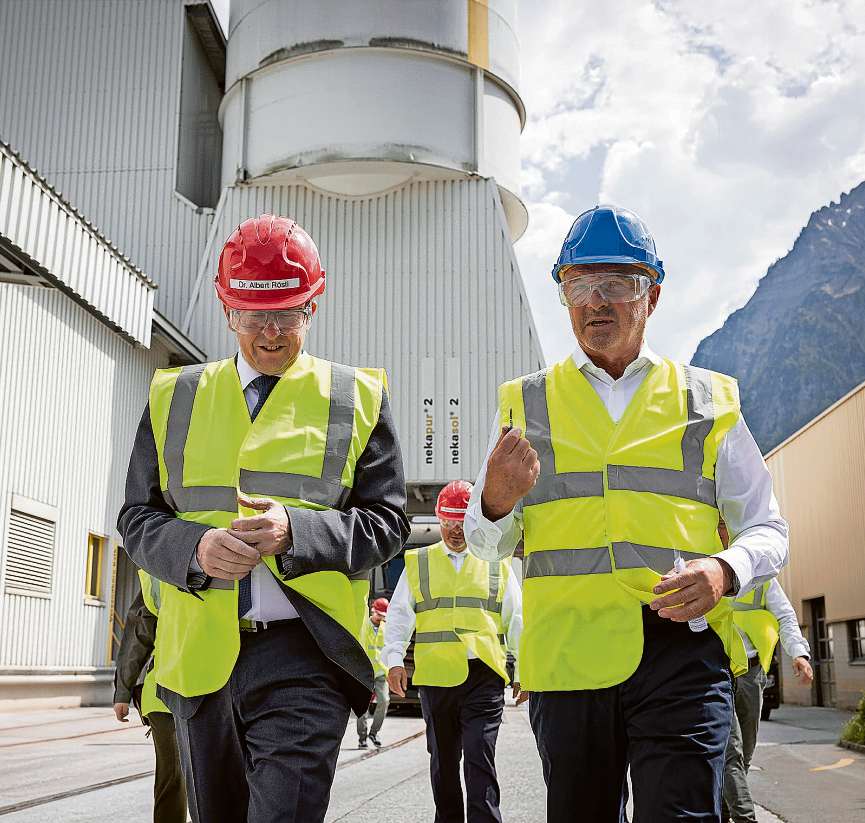Many industries rely on KFN’s high-quality lime products. In many of the possible lime applications, a positive ecological impact can be achieved such as in the flue gas treatment or the treatment of acidic industrial wastewater. The lime production, however, creates inevitable carbon dioxide emissions. KFN, as Switzerland’s only lime plant, has been continuously investing in using the best available technologies in terms of energy efficiency for their lime kiln over the last few decades. Nevertheless, the calcination process emits about the same amount of carbon emission as quick lime is produced. “With a thermal efficiency of 85%, our lime kiln is one of the most energy efficient in Europe, and with natural gas we’re using a low-carbon fuel,” explains Heinz Marti, KFN’s CEO, pointing out the limits of what can be achieved in this regard: “Even by switching to biogenic fuels and green hydrogen, it would be impossible to reduce emissions by more than a further 20%.” This is because the remaining 80% are geogenic emissions coming directly from the limestone itself. The fact that KFN is nevertheless doing everything in its power to operate in a climate-neutral or even climate-positive manner has piqued the interest of Federal Councillor Albert Rösti, Head of the Department of the Environment, Transport, Energy and Communications. For this reason, he recently visited the company to learn more about KFN’s decarbonisation plans.
Liquefying carbon and making it usable
Since the 1990s, KFN has already reduced its carbon emissions from fuel combustion by over 50%. With the carbon capture project, KFN is now accelerating its journey towards a decarbonized lime plant. The plan is to install an oxyfuel firing system with exhaust gas recirculation in the lime shaft’s kiln – a world first for the lime industry. The oxyfuel firing system is combined with a pioneering adjustment to the lime kiln design in order to enrich the carbon dioxide in the exhaust gas to over 75%. With such a high carbon dioxide concentration, KFN can directly process the exhaust gas in a liquefication plant using technologies that already exist on the market. With this innovative capturing approach, no energy-intensive amine scrubbing or pressure-swing absorption is needed. The liquified carbon dioxide can then be utilized or transported to a permanent storage site. Thanks to KFN’s food safety certification (FSSC 22000), it would even be possible to produce food-grade carbon dioxide that could be used by the beverage industry, for instance.
Preparations are in full swing
Oxyfuel firing on the proposed scale for lime kilns does not exist yet, but its potential has been proven by data from simulations and tests. Preparations are currently in full swing. KFN – and its technology partner, Maerz Ofenbau – are currently developing and testing the technology in Netstal. Questions remain about the economics of such an endeavour, as the innovation is associated with high capital expenses and operating costs. Dr Konrad H. Marti, Head of Corporate Development at KFN, is confident that the project can be realised in an economically satisfactory way in the near future: “In a few years, its economic viability should be clear, as we’re also currently seeing further innovation in the field of energy-efficient carbon capture.” Federal Councillor Albert Rösti is also expecting prices in emissions allowances to rise in the future, supporting the economics of carbon capture projects. In addition, the Federal Act on Clime Protection Goals and Innovation might further contribute to such carbon capture projects, even indirectly by providing carbon storage options within Switzerland itself.
Switzerland’s innovative strength benefiting the world
The innovative technology for carbon enrichment in the off-gas developed for the “Carbon Capture at KFN” project has the potential to be applied to many existing lime kilns, and thus reducing carbon emissions globally. KFN expects that it will liquefy about 75% of its daily carbon emissions from the lime kiln. Together with the fact that many lime products act as carbon sinks, meaning that they take up carbon dioxide from air at ambient temperature, a decarbonised lime plant becomes feasible. “With the additional impact from capturing carbon during production, we will succeed in achieving the goals of producing lime in a climate neutral way and even becoming a climate-positive industry,” says a convinced Dr. Konrad H. Marti. Federal Councillor Albert Rösti also sees the project as a significant contribution to national and international climate goals.
(Picture source: Sasi Subramaniam, Südostschweiz.ch)

